“I left school on a Friday and started work on the following Monday,” says Lyle.
Photography Pip Williams
Sign up to our mailing list for the best stories delivered to your inbox.
Lyle and Helen Kent started Kent Saddlery in 1988. They have no plans to retire.
Words Jennifer Johnson Photography Pip Williams
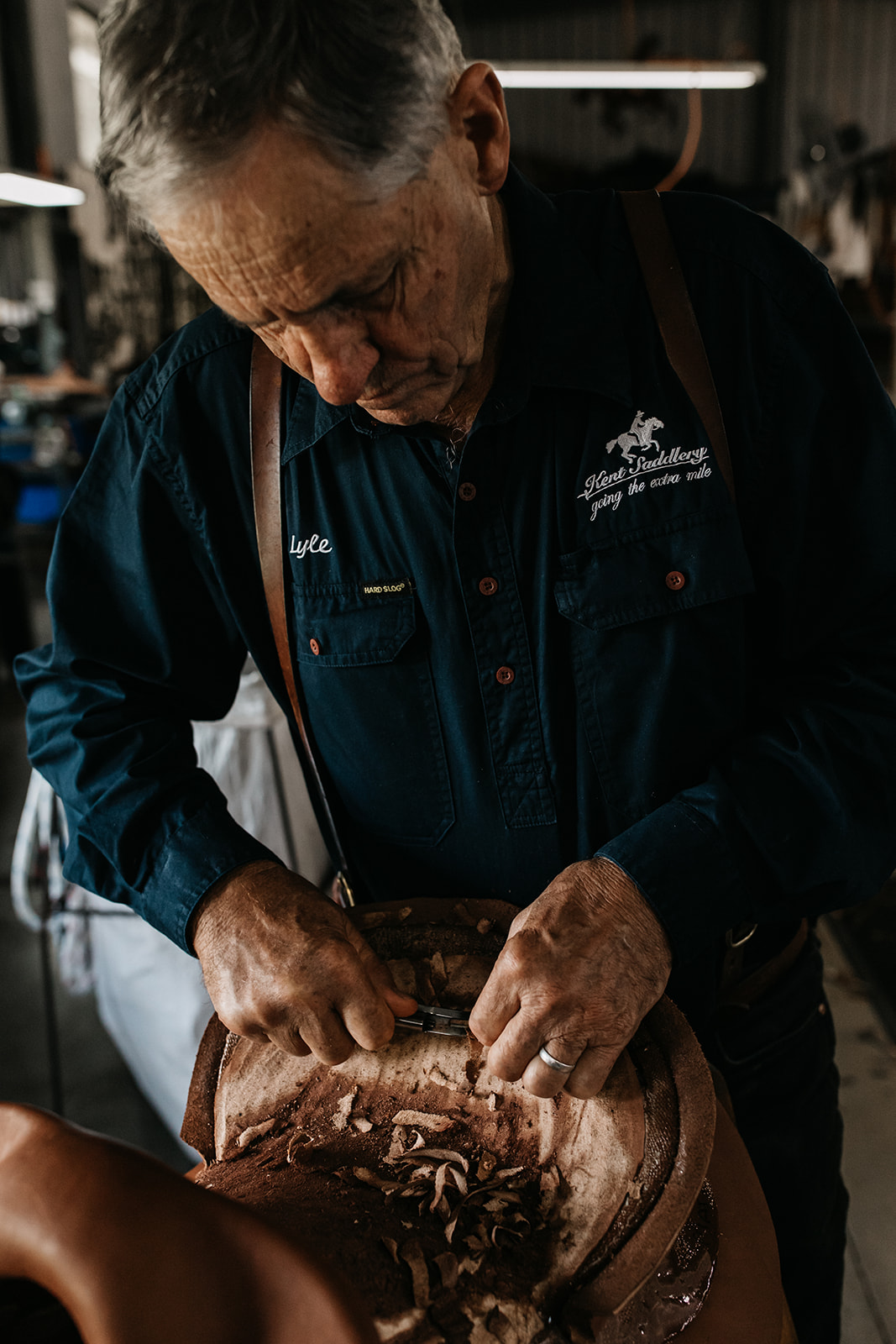
“I left school on a Friday and started work on the following Monday,” says Lyle.
Photography Pip Williams
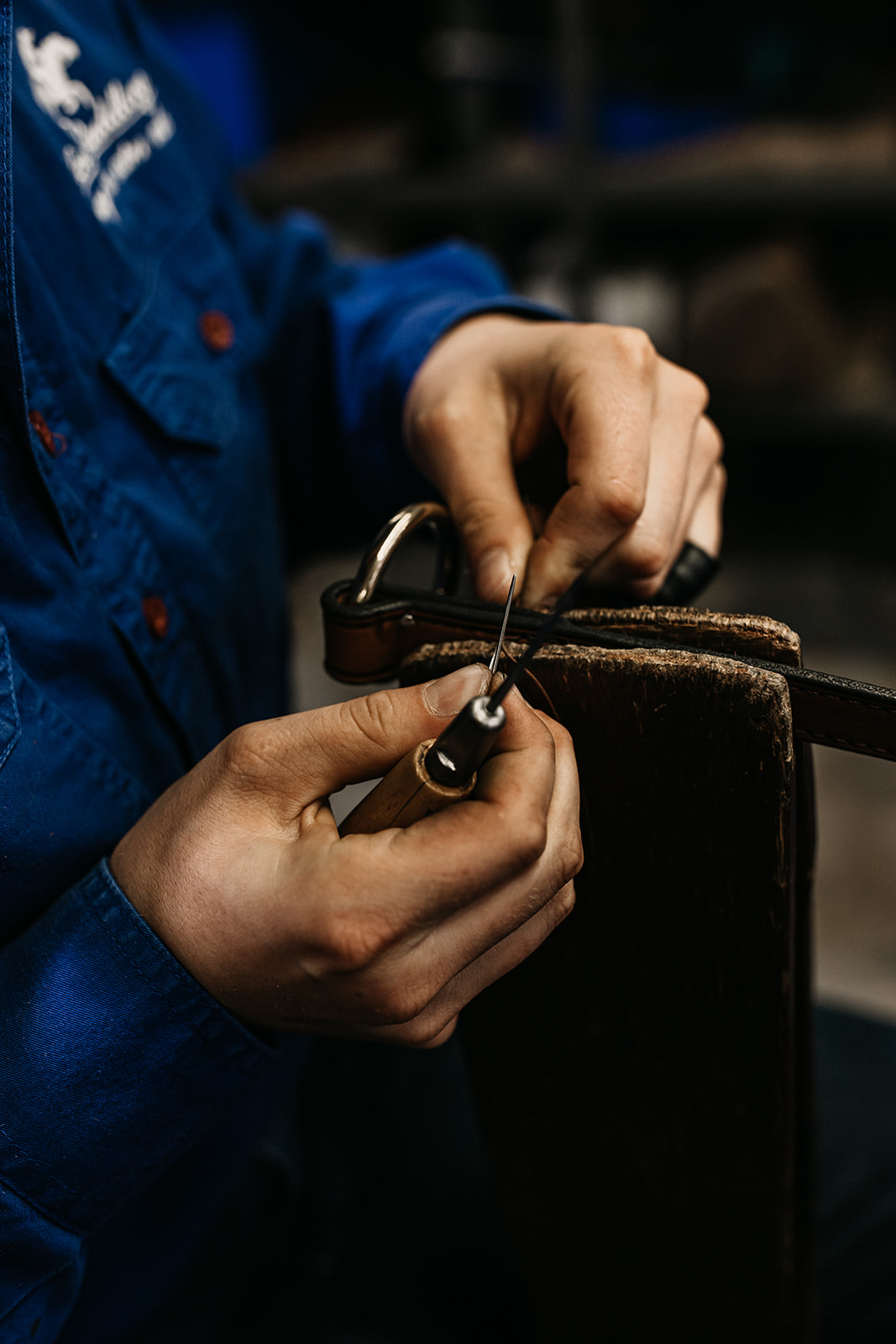
Photography Pip Williams
Lyle and Helen Kent have no idea what the word ‘retirement’ means. The couple, who are both 74, spent six months every year on the road for more than three decades. It was a much-loved time for the master saddler who would pack a truck with pieces made during the ‘off season’ at their Stanthorpe business, Kent Saddlery, and then headed to the outback. Not only did the pair supply remote stations with essential leather goods, they created relationships with the families on these isolated properties, returning year after year for a yarn around the camp fire at night.
“Lyle loves the station lifestyle,” says Helen. “We knew we wouldn’t ever own a cattle station, so getting out on the road and visiting became the next best thing.”
A few years ago, the couple were considering giving up their annual road trip. Lyle remarked to Helen that 30 years was a good number to end on. “So we headed off on what was going to be our last big trip,” Lyle explains, “then Covid came and we had to return home.” Instead, in 2021, “we visited 150 stations in six months. That was 150 very emotional goodbyes,” says Helen.
The couple have not completely given up their road trips. They’ve ‘downsized’, only travelling up to two months at a time. Helen likes their reduced plans.
“There’s always an adjustment time for me, but once I’m on the road I enjoy it,” she says. “I feel like we have two separate lives, our travel life and our home life. It takes time to adjust to each.” She also misses her 16 grandchildren when she’s away.
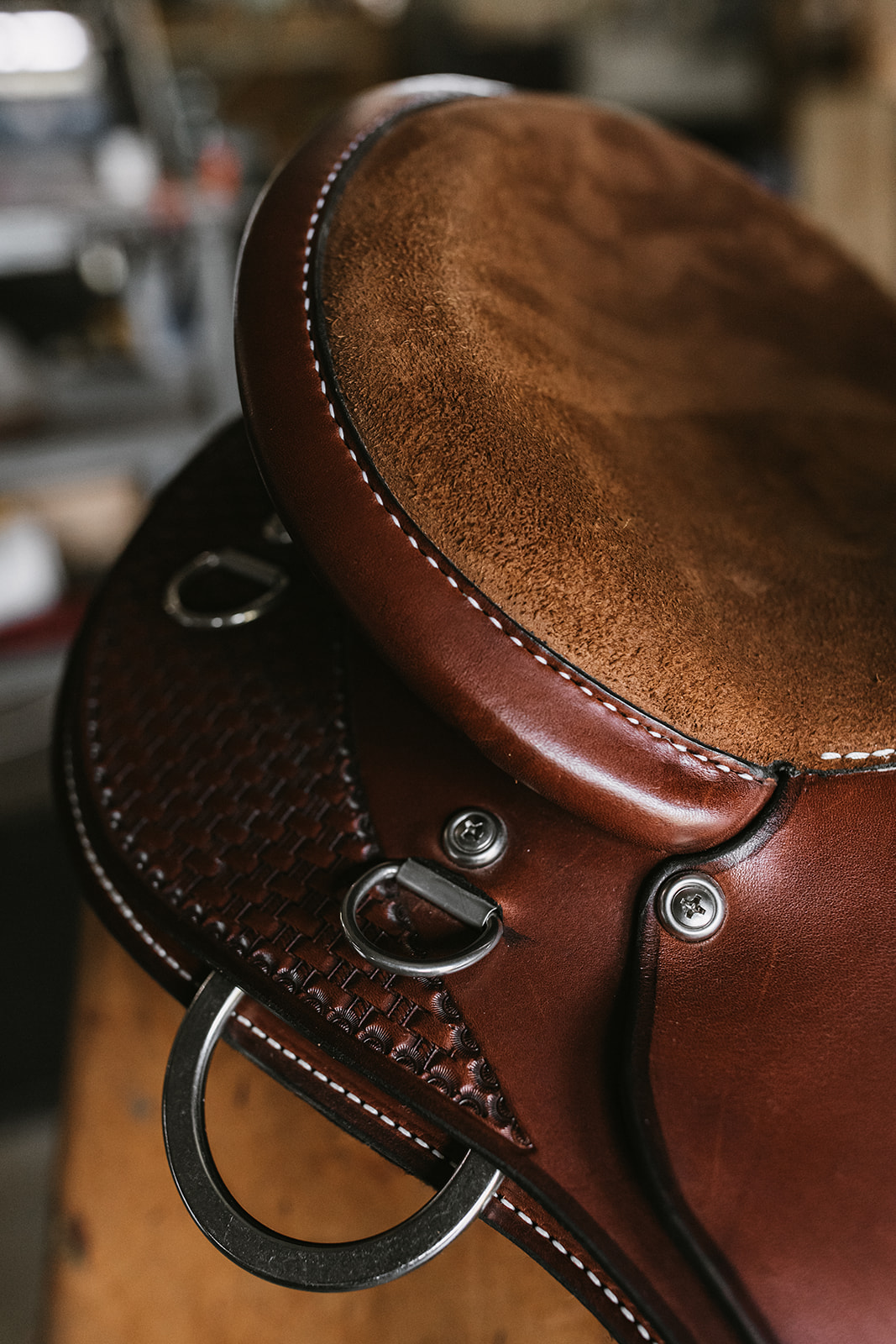
There’s a Kent saddle in many a station tack room across northern Australia.
Photography Pip Williams

Lyle Kent doesn’t know the meaning of the word ‘retirement’.
Photography Pip Williams
In the late 19th century, saddlers were in all the major Australian cities and regional towns. But when graziers began replacing horses with trucks, helicopters and bikes, many small-scale saddleries closed their doors. Yet some managed to survive, and others to establish themselves, in an industry many thought was past its use-by date. In Stanthorpe, 220 kilometres south-west of Brisbane, Lyle and Helen started Kent Saddlery in 1988. They have six children, and three of them continue with the saddle-making tradition, having learned the skills from their father.
Step beyond the automatic front doors into Kent Saddlery’s retail store, where a heavy, pungent smell of leather lingers, and Helen and Lyle are standing behind the heavy timber counter. Their greeting is warm and genuine: “Welcome to Kent Saddlery.” The interior is rustic but modern. Shelves and tables are brimming with merchandise ranging from leather water-bottle pouches, belts and stockwhips to Akubra hats. Hardwood timber floors are partially covered with oriental rugs. Modern glass cabinets hide interior lights that shine over a selection of leather satchels, totes and handbags. Contemporary blue pendant lights suspended by chains from the ceiling cast a warm and inviting glow. The merchandise is for browsing and touching; a textural experience that allows the buyer to appreciate the handiwork of the craftspeople who work behind the retail store.
The workshop at the rear of the building is a large open-plan steel shed with a high-pitched roof. The smell is a mixture of leather and glue. Staff, wearing brightly coloured monogrammed shirts, sit or stand at workstations: the saddlery employs more than 30 workers, with many young faces in the mix.
Kent Saddlery offers a skills-based leatherwork apprenticeship to high school students. Training for Leather Production had been withdrawn in Queensland, but the Kents’ eldest daughter Leah and her husband Josh Furness lobbied the Queensland Government: they were successful in having the apprenticeship reinstated in 2019. Their efforts were doubly rewarded when Kent Saddlery took out the Australian Training Awards Small Employer of the Year in 2020.
“We do the training ourselves because nobody is teaching these skills anymore,” says Lyle. Like a proud father, Lyle introduces me to each worker in the workshop. Perched on a tall seat is Maddie, 20, who is hand-stitching a stockman’s leather belt. Another apprentice is bent over an industrial sewing machine, carefully stitching a contoured wool felt saddle pad, completing his apprenticeship under the watchful eye of Head Saddler and Saddle Department Manager, Daniel Kent.
In 1965, a 15-year-old Lyle left his Stanthorpe home to work on cattle stations. “I left school on a Friday and started work on the following Monday,” Lyle explains. “In those days, it wasn’t unusual to spend five years in the bush.” He worked on stations in western Queensland, before moving to the Northern Territory’s Victoria River district in 1968, first working as a jackaroo on Brunette Downs station.
It was while he was working as a ringer on Humbert River station, south-west of Katherine, that the owner, Charlie Schultz, introduced Lyle to leatherwork, thus igniting his love affair with saddle-making.
“Any spare moment I’d be in the saddle shed repairing leather gear,” recalls Lyle. In 1970, Lyle returned to his childhood neighbourhood and purchased 650 hectares of land at Amiens, on the western side of Stanthorpe. He was a landowner at 20 years of age. He first laid eyes on Helen on December 30 of that year, at a dance in a local church hall.
“The girls sat on benches down one side of the hall and the blokes mingled up the other end. I spotted this young woman with long blonde hair and asked her for a dance.”
Romance blossomed at a New Year’s Eve ball the following night. “We were both 21, and had lived in the same district all our lives, yet we’d never run into each other,” says Helen. They married in 1972. The couple’s first child, Leah, arrived later that year. Four sons followed — Ben, Daniel, Jamie and Paul — and then at last another daughter, Jessica, nine years after Paul. The couple still live on the property Lyle purchased 54 years ago.
Lyle earned money driving a forklift, clearing his property in his spare time, hoping to eventually run cattle. But the 1970s cattle crash put the kibosh on that dream. With cattle prices low, they diversified into vegetable growing. Despite Lyle not being fond of this sort of farming, he persevered for 17 years. During that time he continued his leatherwork and saddle-making, cutting and stitching at a bench in their Amiens home. “Veggie farming is seasonal and very labour intensive,” explains Lyle.
In 1988, Lyle built a workshop out of local granite, a dedicated space behind their house where he could transition into saddlery and leatherwork full time. Helen returned to teaching, ensuring the family had a reliable source of income.
But there was one stumbling block: Stanthorpe and the surrounding region was primarily agricultural. Horses were few and far in between. They’d have to look elsewhere for saddle work. Lyle set his sights on the cattle stations of the Western Australian Kimberley region.
Helen had long realised Lyle’s dreams of becoming a cattle farmer were unlikely to eventuate, and that heading to the cattle stations of the Kimberley might appease him. So, in 1991, Lyle and a pregnant Helen packed four of their five children and their dog Jock into their LandCruiser. Their eldest child, Laura, who was working full time in Toowoomba, stayed behind.
Paul, then eight years old, recalls the road trip. “I asked my father if all the stations we were visiting were train stations,” says Paul, chuckling at the memory. “Dad still laughs about that. I soon realised there were no trains, just cattle. And kids who were pretty wild.”
En route to the Kimberley, the Kents called into stations to repair saddles and take orders. Lyle introduced his boys to the station lifestyle he’d fallen for back in his ringer years. The boys learned how to break in horses, muster and brand cattle while sleeping out under the stars at stock camps. Lyle, with the help of his eldest son Ben, was busy repairing saddles. Orders started flowing in; their business grew. The Kents continued to take to the road each year, as ‘roving’ salespeople. Lyle extended the granite workshop, adding another room, then a few sheds. “But it felt too close to the family home, so in 2012 we moved into larger premises on Stanthorpe’s New England Highway,” says Lyle. The new building provided ample space for a workshop, and out the front they opened their retail store.
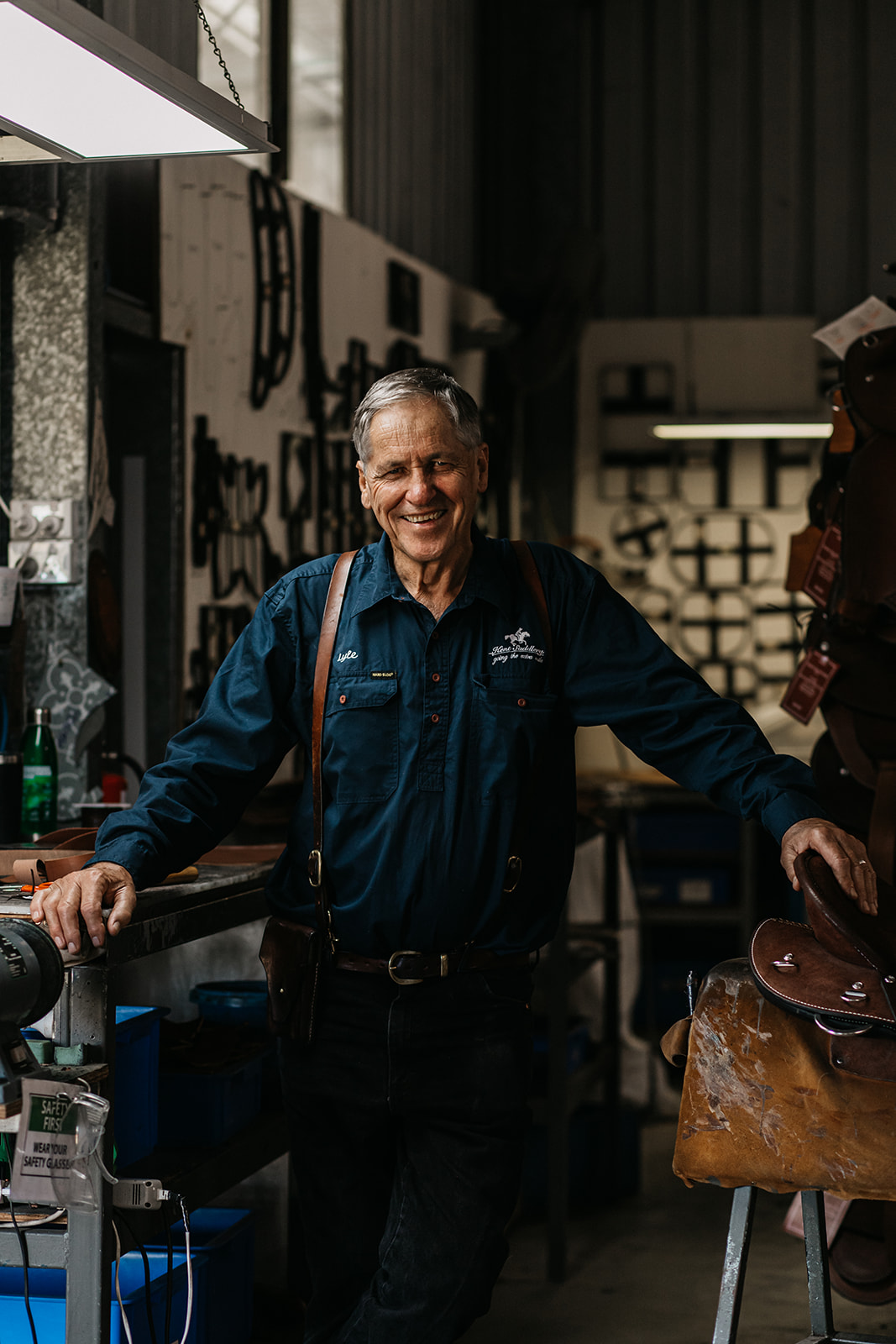
“Any spare moment I’d be in the saddle shed repairing leather gear,” recalls Lyle of his days as a ringer on a cattle station.
Photography Pip Williams
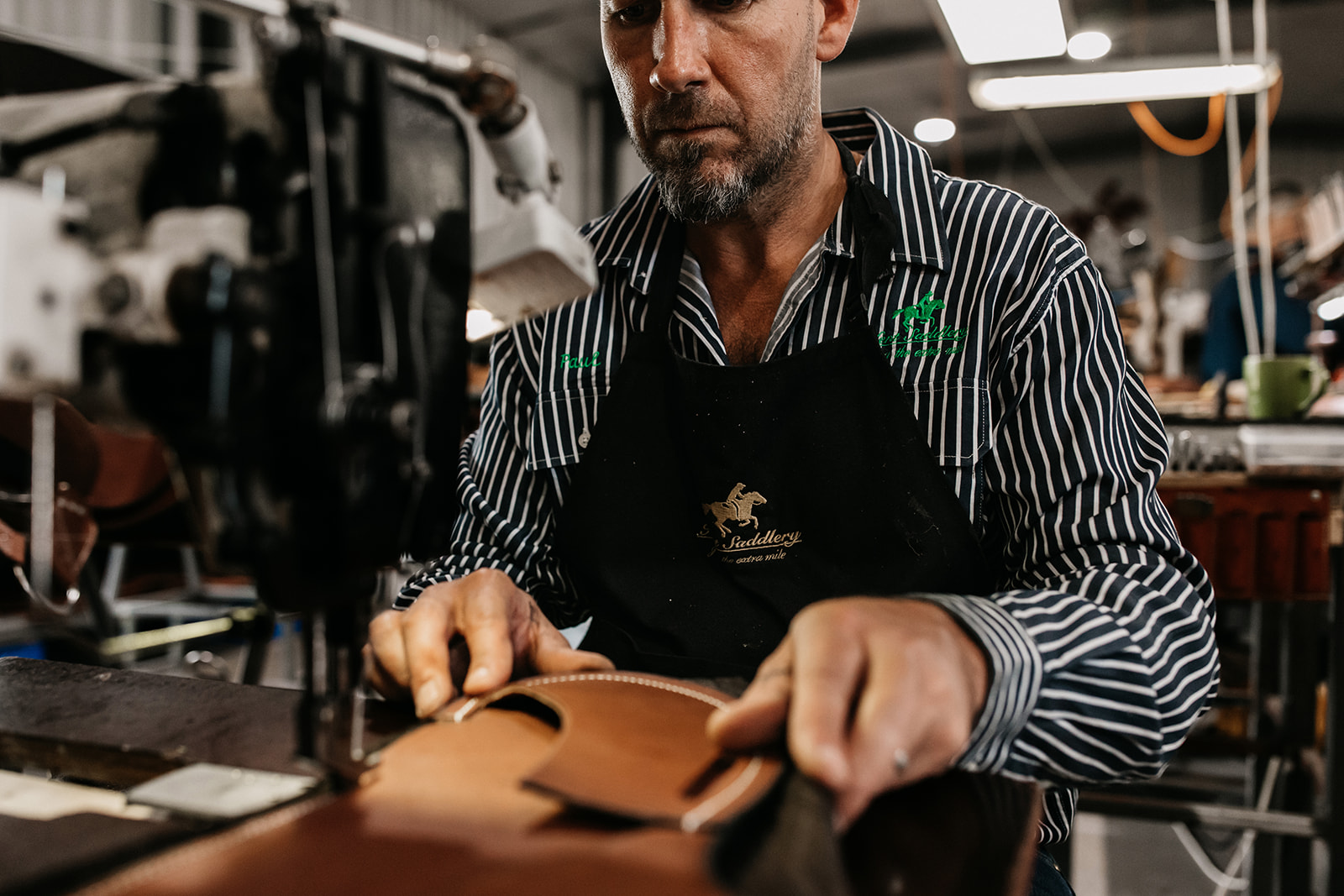
A saddle in progress.
Photography Pip Williams
Like his father, 42-year-old Paul Kent had left school at the end of Year 10. After graduating from a short course at a rural college, Paul worked as a general hand at a cattle station.
“Three years working with horses gave me knowledge of how everything works when it comes to saddles,” explains Paul. He returned to Stanthorpe in 2022 to full-time work at Kent Saddlery. His older brothers Daniel and Ben taught him saddle-making. Today, Paul’s wife Lauren is also involved in the business, working in despatch and laser printing, and they have one-year-old twins.
Daniel Kent, 45, started in the business as a 15-year-old trainee, learning how to twist and wax the threads used for stitching. He transitioned to full-time work in 2002 and is now the main saddle-maker. He is married to Sonia, who also works in the business, and they have five children. His two oldest sons have been helping out in the workshop for the past couple of years.
Ben Kent, 48, currently lives in Longreach, Queensland. He is the pastor at the Reach Christian Church and a father of five. He’s also a saddle-maker, juggling his week — 75 per cent of his time is spent on church ‘stuff’ and the rest on saddle-making. His wife, Janelle, also helps out.
Ben enjoys working with his hands. “There is a rewarding sense of achievement when you screw on the Kent badge at the end of a saddle build,” Ben explains.
In a small, cramped workshop underneath his house, Ben picks up a piece of sandpaper and starts roughing up the rubber: shaping the seat and creating a smoother drop-off for the rider’s thighs. “I think the seat is one of the hardest things to do. It’s shaped by the feel of it,” he explains. “That takes a while: you go steady, but you get faster as you gain confidence.”
Ben sees longevity in their specialised trade. “Horses will never go out of fashion,” he claims reassuringly. “If you want quiet cattle you use horses and dogs. Some people say helicopters and motorbikes have taken over from horses, but they haven’t really. Wise managers and people who like quiet stock know horses are still a big deal.”
Despite the brothers working largely independently of each other, Lyle’s influence and style are noticeable. “We work out our individual style, but mostly it’s the same,” says Ben. “The average buyer wouldn’t know which one of us made their saddle.”
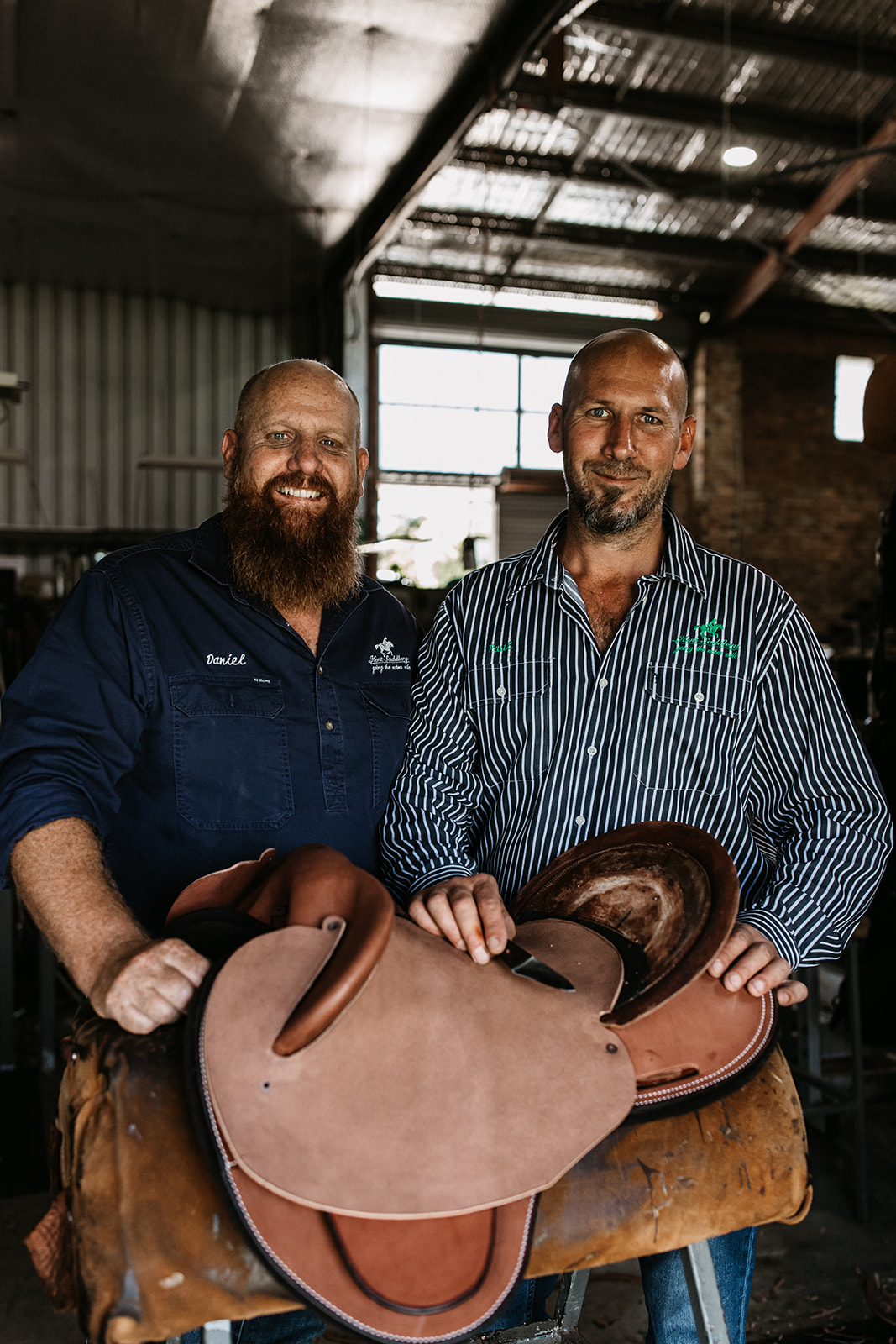
Daniel, 45, and 42-year-old Paul are two of the Kent’s sons who work in the family’s main workshop at Stanthorpe.
Photography Pip Williams
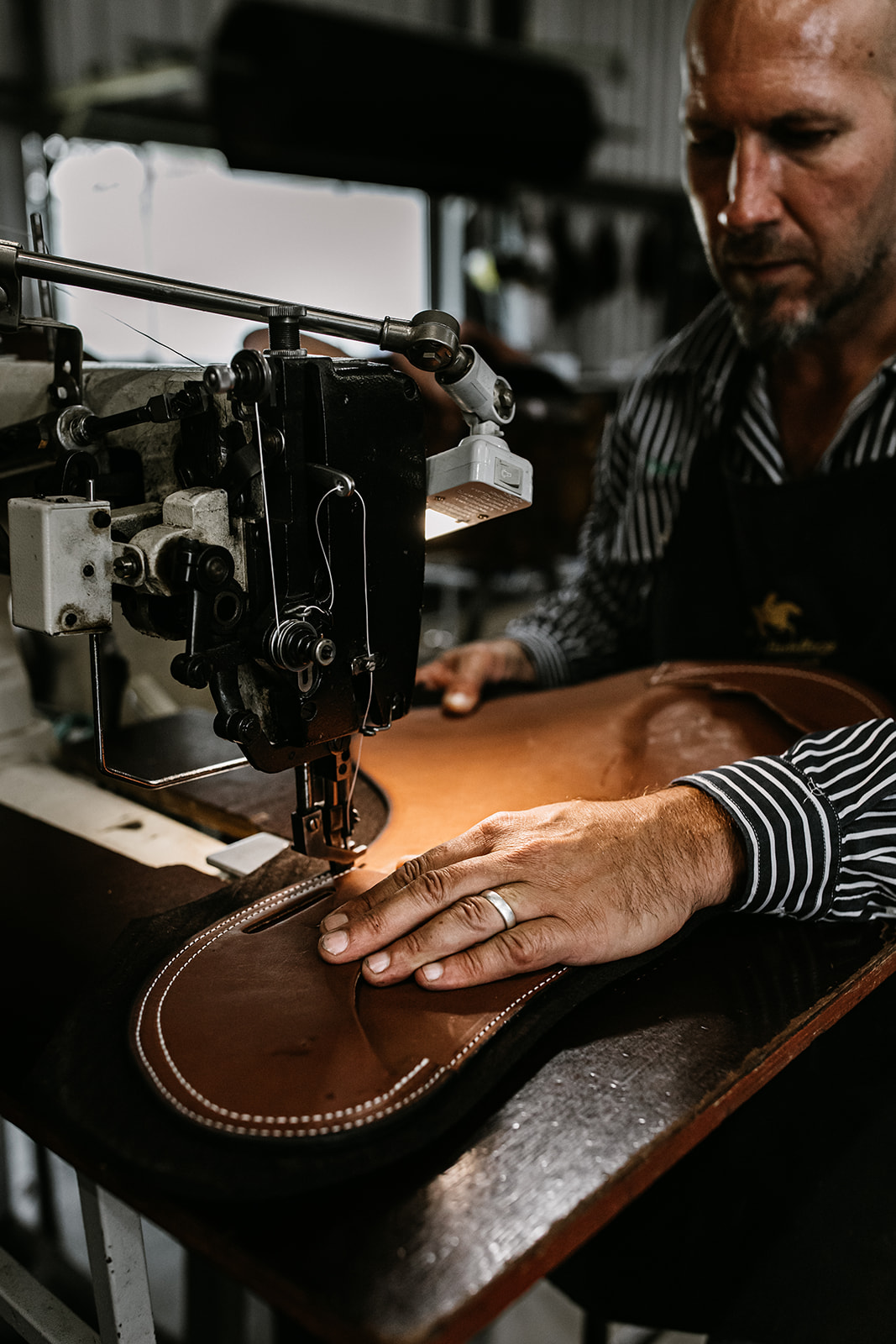
Stitching a saddle.
Photography Pip Williams
Kent Saddlery makes around 200 saddles a year. Each saddler works on two or three at a time. “The tree takes a number of hours to build. The actual saddle build takes two to four days depending on the model and whether any extra add-ons have been requested,” Daniel explains. Many Australian cattle stations will have a Kent saddle or two in their tack rooms. “Mum and Dad’s travels around the country have been a great way to connect with and serve our customers,” Paul adds.
In the workshop they use modern machinery in some areas, but the products and the saddles are mainly stitched, cut and assembled by hand, making each saddle unique. “Foundationally, it’s the love and the passion of working with leather, of keeping traditional leatherworking skills alive,” explains Lyle.
The Kent family plan on keeping the tradition alive for a long time. With some of the next generation showing an interest in stitching, and with school leavers like Caleb undertaking apprenticeships, it looks like the specialised, hands-on craft of saddlery has a solid future.
For more information, visit the Kent Saddlery website.
Subscribe to Graziher and never miss an issue of your favourite magazine! Already a subscriber? You can gift a subscription to someone special in your life.
To hear more extraordinary stories about women living in rural and regional Australia, listen to our podcast Life on the Land on Apple Podcasts, Spotify and all major podcast platforms.
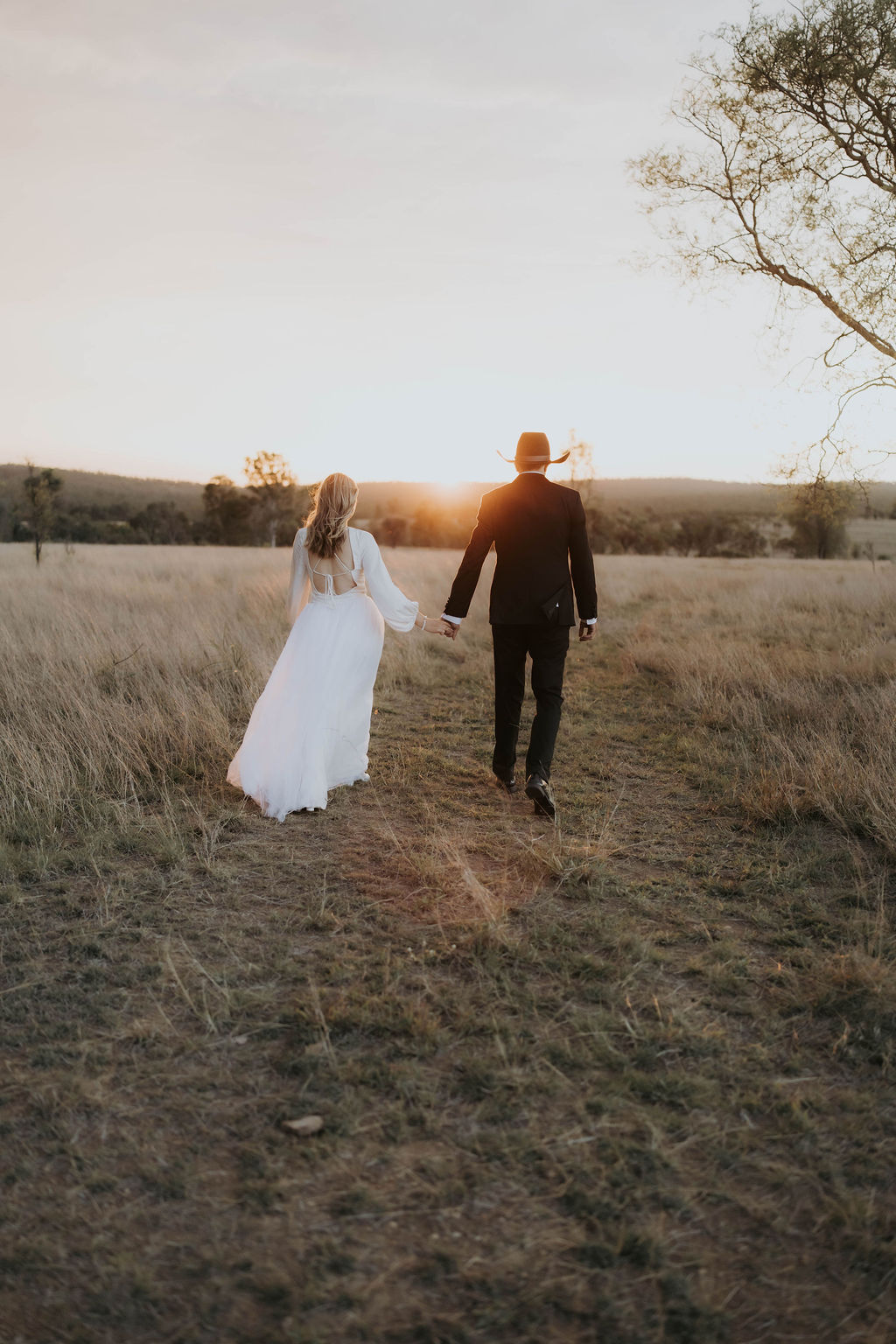
What began as a postcard-perfect country wedding soon became a story of survival, strength, and the unshakable heart of rural Australia.

Current custodian Penny Lamont says the heritage garden is designed for easy-care and dry times.